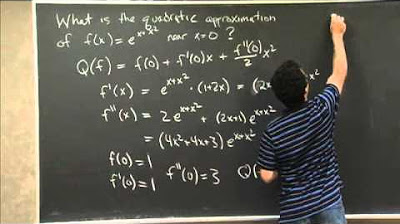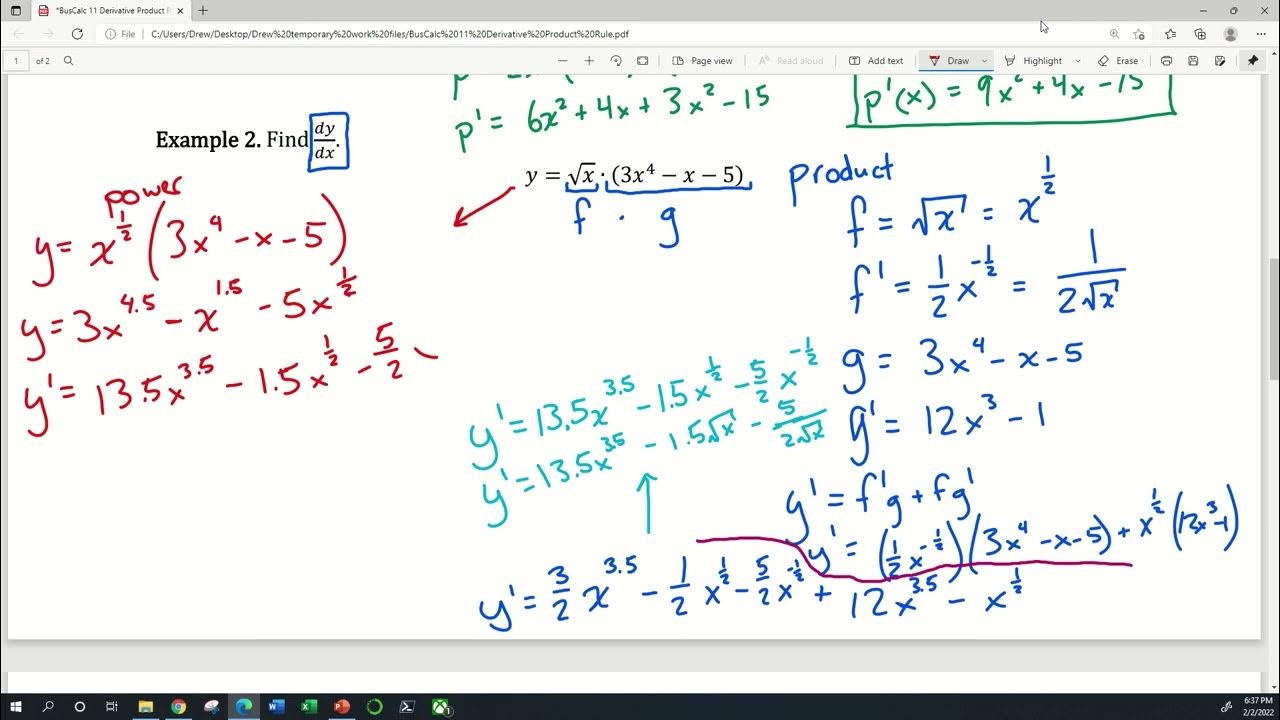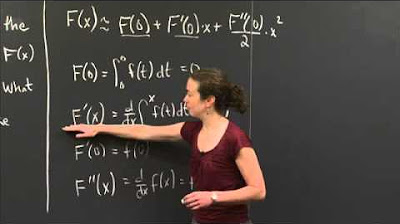Quadratic Approximation of a Product | MIT 18.01SC Single Variable Calculus, Fall 2010
TLDRIn this recitation, the professor explores the concept of quadratic approximations, focusing on their application to the product of two functions. The goal is to demonstrate that the quadratic approximation of a product can be achieved by multiplying the individual quadratic approximations of each function and then simplifying. Using the example of e^x and sin(x), the professor illustrates the process and confirms the validity of this approach through mathematical proof, showing that it is both accurate and efficient.
Takeaways
- 📚 The video aims to demonstrate a theoretical concept involving quadratic approximations.
- 🔢 Q(f) represents the quadratic approximation of a function f at x=0.
- ✖️ The goal is to show that the quadratic approximation of a product of two functions can be obtained by multiplying their individual quadratic approximations and then taking the quadratic approximation of the result.
- 🔍 Example functions: f(x) = e^x and g(x) = sin(x).
- 🧮 Q(f) for e^x at x=0 is 1 + x + x^2/2.
- 🧮 Q(g) for sin(x) at x=0 is x.
- ✅ The quadratic approximation of e^x * sin(x) can be simplified to x + x^2.
- 📝 The process involves using the product rule and higher-order terms, then discarding terms beyond the quadratic.
- 🔄 The method proves that both the direct quadratic approximation and the method of multiplying individual approximations yield the same result.
- 🛑 Higher-order terms (x^3, x^4, etc.) are not included in the quadratic approximation.
Q & A
What is the primary goal of the professor's lecture?
-The primary goal of the lecture is to demonstrate the validity of using quadratic approximations for the product of two functions, by showing that it can be achieved by multiplying the individual quadratic approximations of each function and then taking the quadratic approximation of the result.
What does 'Q of f' represent in the context of the lecture?
-'Q of f' represents the quadratic approximation of the function 'f' at x equals 0, following the formula provided in class.
What is the significance of the quadratic approximation at x equals 0?
-The quadratic approximation at x equals 0 is significant because it provides a simplified model of the function near the origin, capturing the function's behavior up to the second derivative.
Why is the quadratic approximation of a product of two functions considered easier in reality, despite its more complicated notation?
-The quadratic approximation of a product of two functions is considered easier because it leverages the known individual quadratic approximations of each function, thus avoiding the need to compute the derivatives of the product directly.
What is the example given to illustrate the concept of quadratic approximation for a product of functions?
-The example given is f(x) = e^x and g(x) = sin(x), where the quadratic approximations of e^x and sin(x) at x=0 are 1 + x + x^2/2 and x, respectively.
What is the formula for the quadratic approximation of a function at x=0?
-The formula for the quadratic approximation of a function f at x=0 is f(0) + f'(0)*x + (f''(0)/2)*x^2.
How does the professor simplify the process of finding the quadratic approximation of the product of two functions?
-The professor simplifies the process by first finding the individual quadratic approximations of each function, then multiplying these approximations together, and finally taking the quadratic approximation of the resulting expression by keeping only the terms up to x^2.
What is the role of the product rule in the lecture?
-The product rule is used to express the derivatives of the product of two functions, which is necessary for finding the quadratic approximation of the product.
Why is it important to consider only the terms up to x^2 when taking the quadratic approximation of a polynomial at x=0?
-It is important to consider only the terms up to x^2 because the quadratic approximation is meant to capture the behavior of the function near the origin, and higher-order terms have negligible impact in that region.
What is the final step in proving that the quadratic approximation of the product of two functions is equivalent to the product of their individual quadratic approximations?
-The final step is to show that the terms obtained from the quadratic approximation of the product of the individual quadratic approximations match the terms obtained from the direct quadratic approximation of the product of the functions, ensuring no terms are lost in the process.
Outlines
📚 Introduction to Quadratic Approximations
In this introductory paragraph, the professor sets the stage for a theoretical exploration of quadratic approximations. The focus is on demonstrating the validity of a common practice when using these approximations. The professor introduces the notation Q of f to represent the quadratic approximation of a function f at x equals 0, using a specific formula provided in class. The main goal is to show that the quadratic approximation of the product of two functions can be achieved by taking the product of their individual quadratic approximations, which simplifies the process despite the notation's complexity. An example using the functions f(x) = e^x and g(x) = sin(x) is given to illustrate this concept, with the quadratic approximations of each function calculated and then combined to approximate the product of the two functions.
🔍 Detailed Calculation of Quadratic Approximations
This paragraph delves into the detailed process of calculating the quadratic approximation of the product of two functions. The professor begins by multiplying the individual quadratic approximations of f and g, carefully grouping terms to isolate higher-order terms. The process involves evaluating the functions and their derivatives at x equals 0 and then combining these to form the quadratic approximation of the product. The professor emphasizes the importance of recognizing which terms contribute to the x, x squared, and higher-order terms, and then applying the quadratic approximation to the resulting polynomial, which involves retaining only the constant, linear, and quadratic terms while discarding the higher-order terms. The paragraph concludes with the professor highlighting the key terms that contribute to the final quadratic approximation.
📘 Verification of Quadratic Approximation Method
In the final paragraph, the professor aims to verify the method of obtaining the quadratic approximation of a product of functions by comparing it to the traditional approach of directly calculating the derivatives of the product. The professor uses the cheat sheet with the product and derivative rules to express the left-hand side of the equation, which represents the quadratic approximation of the product f*g. The goal is to show that the terms obtained from the product of the individual quadratic approximations (right-hand side) match those from the direct calculation (left-hand side). The professor goes through the process of identifying the constant, linear, and quadratic terms from the direct calculation and demonstrates that they align with the terms obtained from the product of the quadratic approximations. The paragraph concludes with the professor summarizing the lesson, emphasizing that the method of using individual quadratic approximations to find the product's approximation is valid and does not omit any terms.
Mindmap
Keywords
💡Quadratic Approximation
💡Function
💡Derivatives
💡Product Rule
💡Quadratic Term
💡Higher-Order Terms
💡Polynomial
💡Exponential Function
💡Trigonometric Function
💡Cheating Sheet
Highlights
Introduction to the concept of quadratic approximations and their importance in theoretical mathematics.
Explanation of the quadratic approximation formula for a function f at x equals 0.
The goal to demonstrate the validity of a method for approximating the product of two functions using their individual quadratic approximations.
Example given with functions f(x) = e^x and g(x) = sin(x) to illustrate the quadratic approximation process.
Calculation of the quadratic approximation for e^x, which is 1 + x + x^2/2.
Derivation of the quadratic approximation for sin(x), identified as x.
Illustration of how to find the quadratic approximation of the product e^x * sin(x) by using the individual approximations of e^x and sin(x).
Demonstration of the product of the quadratic approximations of e^x and sin(x), leading to a new quadratic expression.
Discussion on the simplification of the resulting expression by dropping higher-order terms for the quadratic approximation.
Introduction of the product rule for derivatives as a foundational tool for the demonstration.
Application of the product rule to show the relationship between the derivatives of the product of two functions and their individual derivatives.
Detailed calculation of the right-hand side of the quadratic approximation equation by multiplying the individual quadratic approximations of f and g.
Explanation of how to group terms to facilitate the identification of constant, linear, and quadratic terms in the product of the quadratic approximations.
Identification of the x^3 and x^4 terms in the product and the rationale for their exclusion in the quadratic approximation.
Finalization of the right-hand side by focusing on the constant, linear, and quadratic terms for the quadratic approximation.
Calculation of the left-hand side of the quadratic approximation equation using the formula for f*g and its derivatives.
Comparison of the terms obtained from both sides of the equation to demonstrate the equivalence of the two methods for finding the quadratic approximation of a product of functions.
Conclusion that the method of using individual quadratic approximations to find the approximation of a product is valid and does not omit any terms.
Transcripts
Browse More Related Video

Quadratic approximation example

Avon High School - AP Calculus BC - Topic 10.11 - Example 1

Quadratic Approximation | MIT 18.01SC Single Variable Calculus, Fall 2010

Using the Trapezoid and Simpson's rules | MIT 18.01SC Single Variable Calculus, Fall 2010

BusCalc 11 Derivative Product Rule

Second fundamental theorem and quadratic approximation | MIT 18.01SC Single Variable Calculus
5.0 / 5 (0 votes)
Thanks for rating: